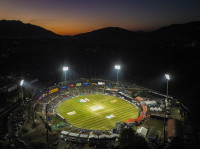Opinion
It’s not just sand
The Valley’s hillocks that absorb rainwater and prevent flooding are being bulldozed
Madhukar Upadhya
As a child, I remember going to the Dhobi Khola on the morning of Ghatasthapana, the first day of Dashain, to bring sand to grow barley seedlings, the holy ‘jamara’. Dashain, the biggest of all festivals of the Hindus, begins with the sowing of barley in a sacred corner of the house on holy sand brought fresh from rivers or streams and worshiped for nine days. On the 10th day, the seedlings are uprooted and given as gifts of Goddess Durga with blessings from elders in the family. It used to be quite a scene on the auspicious day of Ghatasthapana when people would throng nearby rivers to collect sand. But the story now is vastly different. We still grow jamara, but not in sand from the rivers. It is now grown in sand brought from other places. There is no sand in the rivers of the Kathmandu Valley anymore. We mined them all decades ago for concrete and construction projects.
Sand mining in the valley was not an issue until it resulted in the collapse of a major bridge over the Bagmati connecting Kathmandu and Lalitpur at Thapathali in the late 1980s. The collapse of the Bagmati Bridge prompted the government to ban sand mining within certain stretches of bridges. However, there was no restriction on sand mining in other areas; sand mining continued in the unprotected stretches of the rivers due to soaring demand. The next major impact was seen when the deepening of the Bagmati River due to sand mining caused river bank failures, which threatened newly built houses along the banks. Several buildings at Shanti Basti of Dhobighat developed cracks or became tilted, requiring major maintenance. Some of the houses had to be rebuilt completely. With this, the environmental cost of sand mining gradually began to emerge, making mining in the rivers further contentious. Local authorities imposed a complete ban on river sand mining.
Hillocks flattened
Demand for sand increased unabated as Kathmandu rapidly grew into a city of 4 million in less than four decades. The soaring demand has been met by sand hauled from outside the valley at a high cost. But the story does not end there. A rapidly expanding Kathmandu and the building boom increased demand for land to build houses. The lucrative real estate business lured land- and sand-mongers to mine sand from hillocks and sandy slopes around the valley. These slopes have been mined for sand, and the flattened land sold to builders for a hefty price. But in the process, it has created an environmental situation so far largely not understood. What is even more worrisome is the fact that we do not know what will happen when Kathmandu expands further into the foothills, with the planned Outer Ring Road and more satellite cities in the remaining areas around the valley at the expense of sandy slopes.
Sand in the natural environment provides valuable functions in the ecosystem. Not many people realise that sediment in the rivers, as a result of the erosion of sandy slopes, helps build aquatic habitats for spawning and benthic organisms. It is also responsible for providing nutrients to aquatic plants and vegetation in the river bank ecosystems such as floodplains; therefore, it is important for biological diversity.
Given the biological health of the rivers, which are almost dead in the valley, the biodiversity factor may not sound appealing. However, the most important contribution of sandy hillocks, which are as important today as they were in the past and will be even more important for the years to come due to encroachment of the flood plains by expanding peri-urban areas, is perhaps the store room they provide to hold water during and after rainfall. Due to the high permeability of sand, the hillocks soak up a large quantity of water and act as a good buffer to regulate runoff during heavy rains. When these hillocks are gone, so is the store room for rainwater and, with it, the capacity of the landscape to regulate floods in the monsoon. This is one of the reasons the floods in the Hanumante in Bhaktapur in 2018 were so severe; many such sandy hillocks in the river catchments have been lost to the growing sand market. In the absence of the hillocks, part of the rain that would have been stored in them contributed to the increased volume of flood water during intense rainfall.
There is also another side to it. The water stored temporarily in sandy hillocks keeps leaking into the groundwater and continues to feed the streams and aquifers, helping the ecology thrive on non-rainy days too. In the absence of these hillocks, the function of replenishing the aquifers only happens as long as the rain lasts, and not after it stops. The hillocks, a vital part of the landscape which regulate the runoff and replenishing the groundwater, are gradually vanishing in the valley.
Non-renewable resource
Sand, as such, is a non-renewable natural resource, and hence, the most vulnerable to human exploitation in which there seems to be no let-up. The true impact of the loss of sand from the hillocks is anyone’s guess as it has not entered the environmental discourse. The irony is that there is no restriction on collecting sand from private land, and many hillocks in the valley are privately owned. Even on government-owned land, there is not much enforcement of legal precedents because of the interests of powerful sand traders.
What needs to be repeatedly stressed and reiterated is that, unlike water and vegetation, the other two key components of the natural environment, sand is irrecoverable. We know how loss of water impacts us. Yet, when water runs out in the aquifer, we can harvest rainwater to replenish it. We know how the loss of forests impacts us. But we can plant new trees or protect the area to allow natural regeneration. But we do not know the extent of the impact that the loss of sand will have on us. We have seen only some of the impacts. The rest may still need to be explored. When it is lost, it cannot be restored. Although our grandchildren may continue to grow jamara with imported or even artificially-made sand in the future, the lost hillocks will undoubtedly leave lasting, irreversible and perhaps unimagined impacts on our water-based ecosystem in the valley.
Upadhya writes on issues relating to watershed, climate change, disasters and their intersections with society.




 16.12°C Kathmandu
16.12°C Kathmandu










